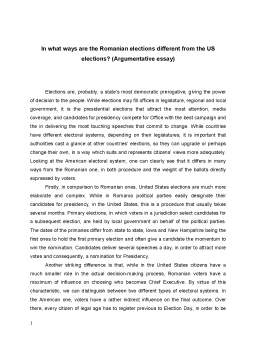Extras din referat
Elections are, probably, a state’s most democratic prerogative, giving the power of decision to the people. While elections may fill offices in legislature, regional and local government, it is the presidential elections that attract the most attention, media coverage, and candidates for presidency compete for Office with the best campaign and the in delivering the most touching speeches that commit to change. While countries have different electoral systems, depending on their legislatures, it is important that authorities cast a glance at other countries’ elections, so they can upgrade or perhaps change their own, in a way which suits and represents citizens’ views more adequately. Looking at the American electoral system, one can clearly see that it differs in many ways from the Romanian one, in both procedure and the weight of the ballots directly expressed by voters.
Firstly, in comparison to Romanian ones, United States elections are much more elaborate and complex. While in Romania political parties easily designate their candidates for presidency, in the United States, this is a procedure that usually takes several months. Primary elections, in which voters in a jurisdiction select candidates for a subsequent election, are held by local government on behalf of the political parties. The dates of the primaries differ from state to state, Iowa and New Hampshire being the first ones to hold the first primary election and often give a candidate the momentum to win the nomination. Candidates deliver several speeches a day, in order to attract more votes and consequently, a nomination for Presidency.
Another striking difference is that, while in the United States citizens have a much smaller role in the actual decision-making process, Romanian voters have a maximum of influence on choosing who becomes Chief Executive. By virtue of this characteristic, we can distinguish between two different types of electoral systems. In the American one, voters have a rather indirect influence on the final outcome. Over there, every citizen of legal age has to register previous to Election Day, in order to be able to cast a ballot. By contrast, in Romania, every neighbourhood has a designated voting precinct, where every citizen of legal age is registered automatically. All they have to do is show up on Election Day and cast a ballot on the candidate they prefer. Unlike in other countries, the vote of Americans is not decisive in the race for presidency. Actually, they are voting for the electors of a candidate, meaning that the voter is not voting the candidate, but endorsing a slate of electors pledged to vote for a specific Presidential and Vice Presidential candidate. In Romania, voters have to choose between several Presidential candidates on their ballots, and no one else can overrule the choice of the people. This is a direct way of electing the President.
After this first step, in Romania, there are two possibilities: either one candidate receives 50% plus 1 from the total of the expressed votes, in which case he or she wins, becoming President, or, if neither one meets the majority of votes, then a run-off is held between the two candidates with the top scores in the first round. The winner is the one who obtains the majority of votes in the run-off.
Preview document
Conținut arhivă zip
- In What Ways are the Romanian Elections Different From the US Elections.docx




